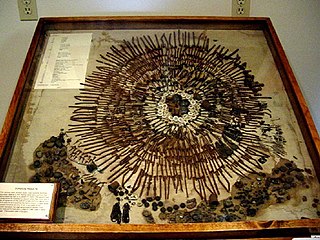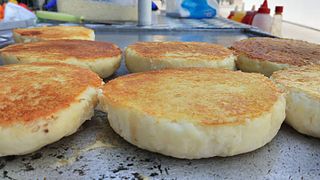
Kaolinite ( KAY-ə-lə-nyte, -lih-) is a clay mineral, with the chemical composition Al2Si2O5(OH)4. It is an important industrial mineral. It is a layered silicate mineral, with one tetrahedral sheet of silica (SiO4) linked through oxygen atoms to one octahedral sheet of alumina (AlO6) octahedra. Rocks that are rich in kaolinite are known as kaolin or china clay. Kaolin is occasionally referred to by the antiquated term lithomarge, from the Ancient Greek litho- and Latin marga, meaning 'stone of marl'. Presently the name lithomarge can refer to a compacted, massive form of kaolin.

Clay is a type of fine-grained natural soil material containing clay minerals (hydrous aluminium phyllosilicates, e.g. kaolin, Al2Si2O5(OH)4).

Pica is the eating or craving of things that are not food. It can be a disorder in itself or a sign of other cultural or medical phenomena. The ingested or craved substance may be biological, natural or manmade. The term was drawn directly from the medieval Latin word for magpie, a bird subject to much folklore regarding its opportunistic feeding behaviors.

Bentonite is an absorbent swelling clay consisting mostly of montmorillonite which can either be Na-montmorillonite or Ca-montmorillonite. Na-montmorillonite has a considerably greater swelling capacity than Ca-montmorillonite.

Placentophagy, also known as placentophagia, is the act of consuming part or all of the afterbirth following parturition in mammals. Parturition involves the delivery of the neonate, as well as the placenta and fetal membranes. The placenta is a critical organ that develops in the maternal uterus during pregnancy to support the fetus. It connects to the baby via the umbilical cord in order to allow nutrient transport, waste excretion and gas exchange between mother and baby. The morphological features of the placenta differ among species, but the function is universal. The behaviour is characteristic to the mother of the majority of placental mammals. Significant documentation has been provided on placentophagy in a range of animals. Anomalies generally include humans and aquatic species, as well as camels. However, the concept is becoming more popular among women in the Western World despite its controversial overtone.

Geophagia, also known as geophagy, is the intentional practice of eating earth or soil-like substances such as clay, chalk, or termite mounds. It is a behavioural adaptation that occurs in many non-human animals and has been documented in more than 100 primate species. Geophagy in non-human primates is primarily used for protection from parasites, minerals supplements and helps metabolize toxic compounds from leaves. Geophagy also occurs in humans and is most commonly reported among children and pregnant women.

Arepa is a type of food made of ground maize dough stuffed with a filling, eaten in the northern region of South America since pre-Columbian times, and notable primarily in the cuisine of Colombia and Venezuela, but also present in the cuisines of Bolivia, Panama and other countries.

Nutrition and pregnancy refers to the nutrient intake, and dietary planning that is undertaken before, during and after pregnancy. Nutrition of the fetus begins at conception. For this reason, the nutrition of the mother is important from before conception as well as throughout pregnancy and breast feeding. An ever-increasing number of studies have shown that the nutrition of the mother will have an effect on the child, up to and including the risk for cancer, cardiovascular disease, hypertension and diabetes throughout life.

Zoopharmacognosy is a behaviour in which non-human animals self-medicate by selecting and ingesting or topically applying plants, soils, insects, and psychoactive drugs to prevent or reduce the harmful effects of pathogens, toxins, and even other animals. The term derives from Greek roots zoo ("animal"), pharmacon, and gnosy ("knowing").
A food craving is an intense desire to consume a specific food, and is different from normal hunger. It may or may not be related to specific hunger, the drive to consume particular nutrients that is well-studied in animals. In studies of food cravings, chocolate and chocolate confectioneries almost always top the list of foods people say they crave; this craving is referred to as chocoholism. The craving of non-food items as food is called pica.

Lucy Wills, LRCP was an English haematologist and physician researcher. She conducted research in India in the late 1920s and early 1930s on macrocytic anaemia of pregnancy, a disease which is characterized by enlarged red blood cells and is life-threatening.
Maternal health is the health of women during pregnancy, childbirth, and the postpartum period. In most cases, maternal health encompasses the health care dimensions of family planning, preconception, prenatal, and postnatal care in order to ensure a positive and fulfilling experience. In other cases, maternal health can reduce maternal morbidity and mortality. Maternal health revolves around the health and wellness of pregnant women, particularly when they are pregnant, at the time they give birth, and during child-raising. WHO has indicated that even though motherhood has been considered as a fulfilling natural experience that is emotional to the mother, a high percentage of women develop health problems and sometimes even die. Because of this, there is a need to invest in the health of women. The investment can be achieved in different ways, among the main ones being subsidizing the healthcare cost, education on maternal health, encouraging effective family planning, and ensuring progressive check up on the health of women with children. Maternal morbidity and mortality particularly affects women of color and women living in low and lower-middle income countries.

The liver of mammals, fowl, and fish is commonly eaten as food by humans. Pork, lamb, veal, beef, chicken, goose, and cod livers are widely available from butchers and supermarkets while stingray and burbot livers are common in some European countries.
The Tsamai people are an ethnic group of southwestern Ethiopia. They speak a Cushitic language called Tsamai, which is one of the Dullay languages, and thus related to the Bussa and Gawwada languages.

The presence of mercury in fish is a health concern for people who eat them, especially for women who are or may become pregnant, nursing mothers, and young children. Fish and shellfish concentrate mercury in their bodies, often in the form of methylmercury, a highly toxic organomercury compound. The element is known to bioaccumulate in humans, so bioaccumulation in seafood carries over into human populations, where it can result in mercury poisoning. Mercury is dangerous to both natural ecosystems and humans because it is a metal known to be highly toxic, especially due to its ability to damage the central nervous system.

The use of medicinal clay in folk medicine goes back to prehistoric times. Indigenous peoples around the world still use clay widely, which is related to geophagy. The first recorded use of medicinal clay goes back to ancient Mesopotamia.
Calabash chalk is a geophagic material popularly consumed in West African countries for pleasure, and by pregnant women as a cure for nausea. Geophagia is the practice of eating the earth, including soil and chalk. This practice is neither new nor outdated and can be associated with religious beliefs, medication or as part of a regular diet. This act can expose the consumer to toxic substances and parasites found in the ingested earth.
Childbirth in Ghana is often seen as a joyous occasion in Ghanaian society, as children represent wealth, status, and the continuation of a lineage. Pregnant women are often given special privileges and are considered to be beautiful, fragile, and vulnerable to evil spirits. Therefore, women may seek guidance from a religious or spiritual diviner to protect their fetus or to increase their chances of conceiving. For example, the Akan may carry akuaba dolls, a fertility symbol, during pregnancy to ensure that they will birth a healthy and beautiful baby that resembles the doll's exaggerated features.

Injera is a sour fermented pancake-like flatbread with a slightly spongy texture, traditionally made of teff flour. In Ethiopia, Eritrea, and some parts of Sudan, injera is the staple. Injera is central to the dining process, like bread or rice elsewhere.
Anemia is a condition in which blood has a lower-than-normal amount of red blood cells or hemoglobin. Anemia in pregnancy is a decrease in the total red blood cells (RBCs) or hemoglobin in the blood during pregnancy. Anemia is an extremely common condition in pregnancy world-wide, conferring a number of health risks to mother and child. While anemia in pregnancy may be pathologic, in normal pregnancies, the increase in RBC mass is smaller than the increase in plasma volume, leading to a mild decrease in hemoglobin concentration referred to as physiologic anemia. Maternal signs and symptoms are usually non-specific, but can include: fatigue, pallor, dyspnea, palpitations, and dizziness. There are numerous well-known maternal consequences of anemia including: maternal cardiovascular strain, reduced physical and mental performance, reduced peripartum blood reserves, increased risk for peripartum blood product transfusion, and increased risk for maternal mortality.














